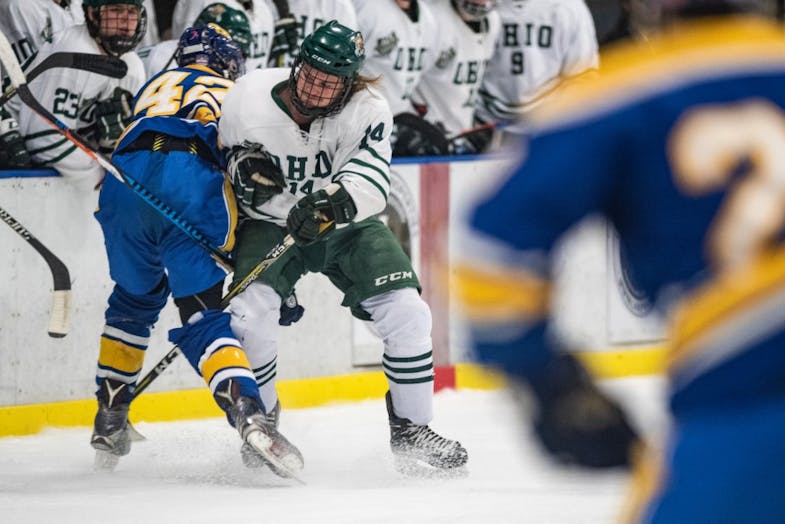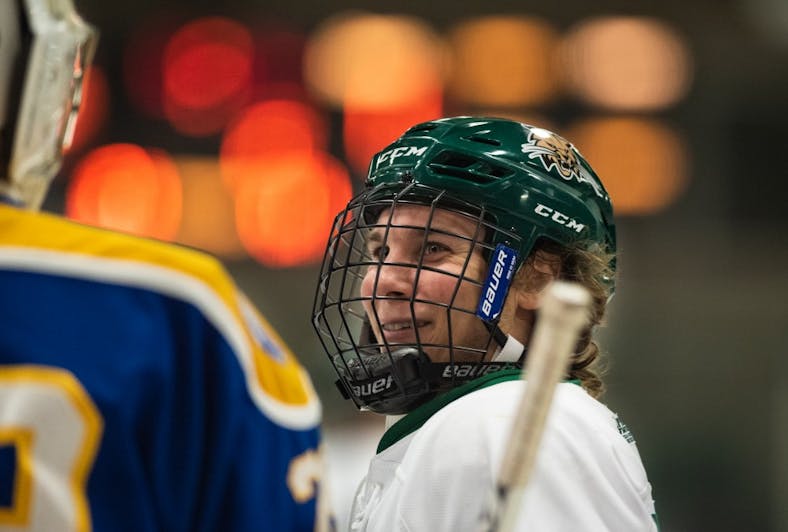Shawn Baird lowered his body into the waist of an unsuspecting Pitt skater and knocked him off his feet. As he skated away, Baird turned his head toward the momentarily motionless victim and mouthed a slew of words that couldn’t be translated by the crowd in Bird Arena.
A few moments after the hit-and-run, the same sequence happened, but in reverse.
In a game where physicality rules, there’s one physical aspect that is never seen on the scoresheet at the end of games: who chirped and who didn’t.

Ohio’s Shawn Baird (#14) checks Pitt’s Jacob Tepe (#42) into the bench during the two teams’ game on Jan. 18, 2019.
Chirping, or trash-talking, has long been a part of sports. From parents in little league games to professional athletes on the biggest stages. On the ice, chirping is not only allowed, but it’s rooted for and expected — but only if you’re the winning team, like senior forward Gabe Lampron learned in his early playing days.
At 10 years old, Lampron was already trying to get in the head of his opponents, not by his game, but with his words. With his team down 10 goals in a pee-wee league game, Lampron still talked until the final horn sounded.
His game changed that day — not solely because of the loss, but because of what his father had said to him afterward.
“My dad was pretty furious with me,” Lampron said. “He was just like, ‘When you guys are losing by 10 goals and you’re still running your mouth, you just look like an idiot, and you make an ass out of yourself.’”
From that moment on, Lampron decided that if he kept his mouth closed, his game would do the talking. He saw his father’s point and agreed that there is a time and a place to chirp.
“It’s pretty hard, and now whenever I see people do it, I agree that they look like idiots.”
That’s not to say, however, that Lampron doesn’t open his mouth from time to time and let players from the other team hear it.
At least in Lampron’s case, he only chirps when an opposing play makes a dirty hit or does something that Lampron doesn’t like.
Some players are witty with their chirps and insults. Others, like Lampron, keep it simple.
“It’s usually just me screaming profanity at the top of my lungs,” he said. “Or saying I’m going to injure someone. It’s not good.”
While Lampron might not be the biggest or best chirper on the team, he doesn’t need to be. On a roster of 24 skaters, players such as Baird, Tom Pokorney, Jake Houston and Jimmy Thomas bring that element as a part of their game.
Pokorney is known throughout the American Collegiate Hockey Association as one of the most emotional players. It’s a trait he relishes in.
The senior defenseman is no stranger to yapping at his opponents before, during or after the whistle is blown. Sometimes it’s for a reason, other times it’s not. Sometimes he knows the player, other times he doesn’t. Sometimes he gets in their heads, other times he’s unsuccessful.
Throughout the 12-0 dismantling that Ohio bestowed upon Pitt on Jan. 18, Pokorney talked from start to finish.
“I was saying, ‘It must be kind of embarrassing coming here every year and having me call it ‘point night’ for us,” Pokorney said.
“Point night” means that every player on the roster scored a point.
As the game went on, the chirps got more and more ruthless from Pokorney, ranging from telling Pitt to go down to Division II to asking a player if it was his first time on the ice. The bigger the score differential, the worse the chirp.

Junior forward Tyler Harkins (#22) talks to a Pitt player during the two team’s game on Jan. 18. 12-0.
Of course, there are different kinds of chirps for different opponents. Against a team such as Pitt, the game warrants a little less creativity. Against quality teams such as Lindenwood or Illinois, however, it requires a little more knowledge of the roster.
In last year’s Central States Collegiate Hockey League semifinal game, Pokorney told then-Illinois forward James McGing that he wasn’t as good as his brothers. McGing’s brothers, Hugh and Liam, both had successful careers at NCAA Division I programs — Western Michigan and Arizona State, respectively. Hugh was selected in the fifth round by the St. Louis Blues in the 2018 NHL Draft.
While Pokorney’s chirp was one of intellect, James and the Illini went on to win that game.
“He was one of the more disliked players we’ve played against, but he kept firing back and ultimately won,” Pokorney said.
Chirping, like net-front screens or blocking shots, is an important aspect of the game. While there is no metric to gauge who’s good at it or who’s not, it remains vital in some regards. It’s given players a reputation, some in a good light, others in a bad light.
But overall, it’s a component to the game that differentiates it from other sports.
“It’s all a part of the game,” Pokorney said. “All it’s meant to do is take a player’s mind off the game.”





